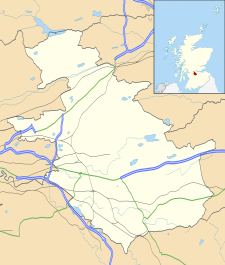
Hartwood is a village in North Lanarkshire, Scotland. Nearby settlements include Shotts, Allanton and Bonkle. The area is rural, with fewer than 50 houses. Transport is provided at Hartwood railway station, operated by Network Rail, with an hourly service Monday - Saturday every hour between Glasgow Central and Edinburgh Waverley on the Shotts Line.

The State Hospital is a psychiatric hospital located close to the villages of Carstairs and Carstairs Junction, in South Lanarkshire, Scotland. It provides care and treatment in conditions of high security for patients from Scotland and Northern Ireland. The hospital is managed by the State Hospitals Board for Scotland which is a public body accountable to the First Minister of Scotland through the Scottish Government Health and Social Care Directorates. It is a Special Health Board, part of the NHS Scotland and the only hospital of its kind within Scotland.

Chryston is a village in North Lanarkshire, around 7 miles (11 km) east of Glasgow, in Scotland. It lies north of its sister village, Muirhead, which is on the A80. The village has around double Muirhead's population, although the exact boundary between the two modern villages is difficult to find.

University Hospital Hairmyres is a district general hospital in the Hairmyres neighbourhood of East Kilbride, South Lanarkshire, Scotland. The hospital serves one of the largest elderly populations in Scotland. It is managed by NHS Lanarkshire.

Stobhill Hospital is located in Springburn in the north of Glasgow, Scotland. It serves the population of North Glasgow and part of East Dunbartonshire. It is managed by NHS Greater Glasgow and Clyde.

Moodiesburn is a village in Scotland, located 8 miles northeast of Glasgow, in the North Lanarkshire council area. It is situated on the north side of the A80 road and between the M73 and M80 motorways which converge nearby. Moodiesburn does not directly adjoin any other settlements, though the villages of Chryston and Muirhead are located a short distance to the west, with Stepps beyond, and outer parts of Cumbernauld lie to the east; however, the town centres are about 5 miles apart.

Gartnavel Royal Hospital is a mental health facility based in the west end of Glasgow, Scotland. It provides inpatient psychiatric care for the population of the West of the City. It used to house the regional adolescent psychiatric unit but this has recently moved to a new psychiatric unit at Stobhill Hospital. The Hospital is a venue used by the Mental Health Tribunal for Scotland. Some parts of the hospital are classified as a category A building and are also deemed at risk.
NHS Lanarkshire is responsible for the health care of more than 652,000 people living within the council areas of North Lanarkshire and South Lanarkshire in Scotland, making it the third largest health board in the country after NHS Greater Glasgow & Clyde and NHS Lothian. NHS Lanarkshire employs approximately 12,000 staff. The board is based at Kirklands, Fallside Road in Bothwell, South Lanarkshire.

NHS Ayrshire and Arran is one of the fourteen regions of NHS Scotland. It was formed on 1 April 2004.

St John's Hospital is the main general hospital in Livingston, West Lothian, Scotland. Located in the Howden area of the town, it serves Livingston and the wider West Lothian region. St John's is a teaching hospital for the University of Edinburgh Medical School. It is managed by NHS Lothian.

University Hospital Wishaw is a district general hospital in Wishaw, North Lanarkshire, situated between the areas of Craigneuk to the north and Netherton to the south. The hospital, managed by NHS Lanarkshire, is 11 miles southeast of Glasgow.

Woodilee Hospital was a psychiatric institution situated in Lenzie, East Dunbartonshire, Scotland.

Stracathro Hospital is a community hospital in Angus, Scotland. Established as a wartime Emergency Hospital Service facility during the Second World War, it was afterward developed as a District General Hospital. Since 2005 it has been the site of the Scottish Regional Treatment Centre.

Blackberry Hill Hospital is an NHS psychiatric hospital in Fishponds, Bristol, England, specialising in forensic mental health services, operated by the Avon and Wiltshire Mental Health Partnership NHS Trust. The hospital also offers drug and alcohol rehabilitation inpatient services, and is the base for a number of community mental health teams.

Forth Valley Royal Hospital is a hospital located in Larbert, Scotland. With 860 inpatient beds, 25 wards, and 16 operating theatres, it was Scotland's largest ever NHS construction project at the time but has been surpassed by the Queen Elizabeth University Hospital amongst others. Built at a cost of £300 million on the site of the old Royal Scottish National Hospital, it opened to its first patients in 2010. It is operated by NHS Forth Valley.
Woodilee Village is an enlargement to the town of Lenzie in the Kirkintilloch area. The local authority is East Dunbartonshire.
Events from the year 1913 in Scotland.

Hartwood Hospital was a psychiatric hospital located in the village of Hartwood near the town of Shotts in Scotland.

Kirklands Hospital is a mental health facility in Bothwell, Scotland. It is managed by NHS Lanarkshire.

Udston Hospital is a health facility in Farm Road, Hamilton, South Lanarkshire, Scotland. It is managed by NHS Lanarkshire.




















